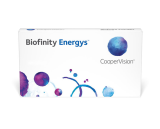
It’s natural to lament the loss of youth, especially as it affects vision and health. However, there have been so many discoveries in recent years, aimed at helping adults maintain a youthful lifestyle and appearance with age. The need for near vision correction is a perfect example. Once you hit the age around 40 to 45, objects close up start to look blurry thanks to a condition known as presbyopia. Your parents or grandparents probably used reading glasses once presbyopia set in. But, thanks to modern contact lens designs made specifically for aging adults, you probably won’t need to carry reading glasses along with you everywhere you go.
Presbyopia: Will It Happen To You?
The short answer is “yes.” Presbyopia is a normal, age-related condition that affects everyone who lives long enough to develop it. Typically, it sets in around the end of the fourth decade of life—even if you used to have perfect vision.
Presbyopia makes it more difficult to focus on objects up close due to changes in your eye’s crystalline lens. As you age, this lens becomes thicker, harder and less flexible. If you’re over 40 and feel like you need to hold menus and newspapers further away to help your eyes focus, you probably have presbyopia.
If Glasses Aren’t Your Thing
Some people are okay with wearing glasses part or all of the time, but if you’re not, talk to your doctor about contact lens approaches to presbyopia correction. There are many more contact lens options today than there used to be.
In the past, the most popular way to compensate for presbyopia with contact lenses alone was with a technique called monovision. People who wear monovision contact lenses are given a prescription for near vision in one eye and a lens for distance vision in the other eye. This approach is still in use today, but it prevents your two eyes from working together optimally, so it may not the ideal way to correct vision. A newer option is multifocal contact lenses, which contain multiple zones of vision correction instead of just one. This allows both your eyes to work together, allowing you to see things both up-close and at a distance.
What If?
Since multifocal contact lenses are a newer technology, you may have heard stories about certain people who weren’t candidates due to other conditions or lifestyle needs. Fortunately, today you can find multifocal contact lenses for even the most specific needs. For example, if you like to wear a fresh pair of lenses every day, clariti 1 day multifocal is a silicone hydrogel, daily disposable contact lens. Silicone hydrogel lenses are a healthier* alternative to hydrogel daily disposables. That’s because they allow more oxygen to pass through to your corneas than hydrogel lenses do. If you have astigmatism, Proclear® multifocal toric contacts address both presbyopia and astigmatism.
Soft multifocal lens choices were once very slim, but today there are options. When starting with any multifocal lens, there is an adjustment period during which time your brain has to get used to a new way of seeing. However, many people consider this a small price to pay for eliminating the inconvenience of reading glasses.
*With higher oxygen permeability than hydrogel materials, silicone hydrogel contact lenses minimize or eliminate hypoxia-related signs and symptoms during lens wear.
Nothing in this blog post is to be construed as medical advice, nor is it intended to replace the recommendation of a medical professional. For specific questions, please see your Eye Care Practitioner.





